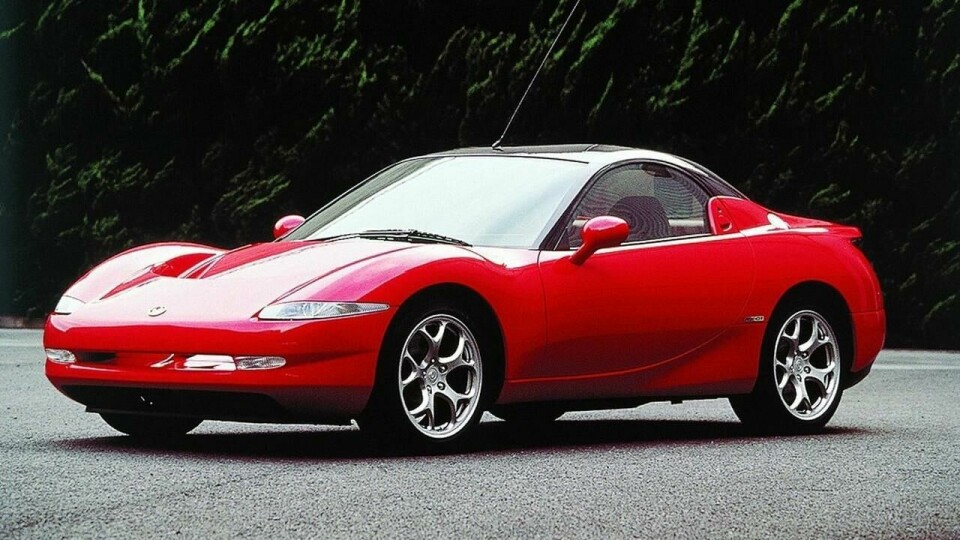
Concept Car of the Week: Mazda RX-01 (1995)
The Mazda RX-01 concept was smaller and lighter than the standard street version of the RX-7 and adopted a radically different aesthetic
Mazda sports cars have a long and storied history and the RX-7 and the MX-5 are among the most colourful.
By the 1990s the original spirit of the RX-7 – light, fun, affordable – had been successfully co-opted by the MX-5, and the RX-7 had long since moved upmarket to compete with Porsche. But times were changing, and the sports car market was declining, and Japan was mired in its ‘lost decade’ of economic stagnation. Mazda sought to reposition the RX-7 back to its roots.
To this end, Mazda introduced a new kind of rotary sports car at the 1995 Tokyo Motor Show, the RX-01. The car was smaller and lighter than the standard street version of the RX-7, and adopted a radically different aesthetic.

The production RX-7 (FD) in 1995
The RX-01 was fitted with a next-generation rotary engine, the 13B-MSP. It was naturally aspirated, as opposed to the twin-turbo setup found in the contemporary RX-7. The exhaust ports were relocated, too, for better timing and higher output, as well as better fuel economy and cleaner emissions.
The new engine was placed just behind the front wheels and hard up against the firewall. The battery and fuel tank were placed between the rear wheels as a sort of counterweight, resulting in great weight distribution and excellent handling.

The engine bay of the RX-01
With the engine set so far back, the body could be sculpted at the front to improve aerodynamics. The hood dove down steeply and a ‘floating’ front wing was placed over it.
Looking at the front elevation, one sees a fairly standard sports car mask. But from the driver’s seat looking down the hood one looks into that gap between wing and hood, and sees naught but pavement. It was a dramatic effect, to say the least.

RX-01 featured a unique integrated front wing
The cabin was what Mazda called “a true 2+2” layout, meaning the rear seat was unusable except as a leather-clad lounge for your briefcase or purse. The front of the cabin had two racing-inspired seats, red leather and carbonfibre trim, and a host of racing-inspired gauges.

The racing-inspired cabin, with 2+2 seating
At the rear of the car, two strakes trailed back from the cockpit and terminated at the rear spoiler. The spoiler projected over an organically curved rear fascia and black edge-to-edge tail light bezel (the lights themselves were round).

Organic curves at the rear complementing dramatic sculpting at the front
Alas, the RX-01 was born too soon – or perhaps too late. Mazda’s precarious financial situation invited an investment from Ford, and the accountants from the Blue Oval were none too keen on any “zoom-zoom” fantasies of a new sports car – especially when the MX-5 was selling so well. Additionally, consumer surveys showed the buying public trending towards family vehicles (personal luxury coupés also declined in sales at this time). But the 13B-MSP rotary engine would survive to become the powerplant of the Mazda RX-8.

The RX Vision Concept of 2015; the shape of things to come?
Almost twenty-five years later, the quality of Mazda design and engineering – in both rotary and traditional ICE engines – is near the top of the entire automotive industry. The beautiful RX Vision coupe gives us a glimpse of the future, one beyond the MX-5 and the RX-7 and -8 (dare we call it the RX-9?)
Bonus: Mazda MX-5 Mono-Posto

Introduced at the 2000 SEMA show, the Mono-Posto was an NB series MX-5 altered to enhance the car’s retro spirit, and evoke classic racers from the likes of Lotus and Jaguar.

The year 2000 production version of the MX-5
Although the Mono-Posto looks like Mazda just capped off the passenger side of the cockpit, only the headlights, tail lights, and rear deck lid remain the same. Everything else is new sheetmetal – astonishing when you consider how much the Mono-Posto looks like the street version. The wheels are 18-inch alloys backed up by four-wheel disc brakes.

Almost every panel of the Mono-Posto was new
The cockpit was stripped down to racing spec, all creature comforts removed. A Sparco steering wheel and racing seat were installed, as was new instrumentation on the panel and at the side of the driver. Aluminium lined the floor and lower cockpit sides.

No-nonsense racing interior
The engine was a custom version of the 1.8-litre inline four. A custom charger and intercooler, along with stainless steel exhaust system as well as intake and exhaust manifolds. The horsepower and torque rose substantially, with horsepower rated at 190hp and torque measured at 243 lb/ft.

Classic looks and friendly face preview the “Cars” movie franchise
The Mono-Posto was strictly for the SEMA show, no plans for production were ever put forward. Still, a number of customizers were inspired by the concept and there have been a few copies made over the years, with mixed results in terms of design and fabrication quality. Given the fact that almost every exterior panel was custom fabricated, it is easy to see that copycats would have a quite a challenge creating their own Mono-Posto.
The Mono-Posto is so pure, so classic, it is easy to long for a production version, even though the market for such a car would be prohibitively small. Still, one can dream…
–
If you want to see the RX-01 in action, check out this Top Gear segment with host Andy Wilman:



